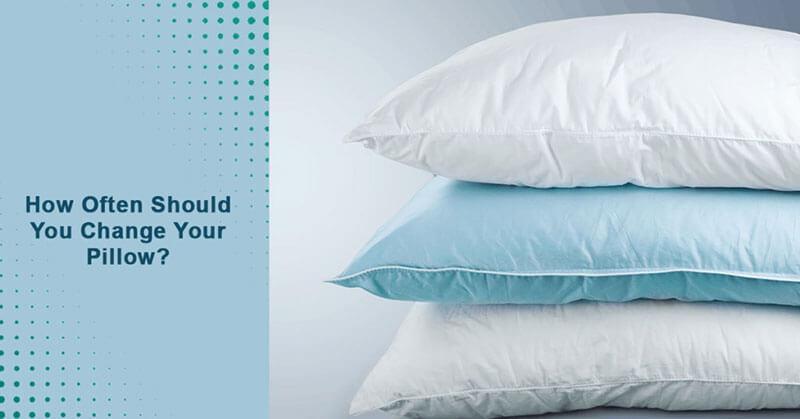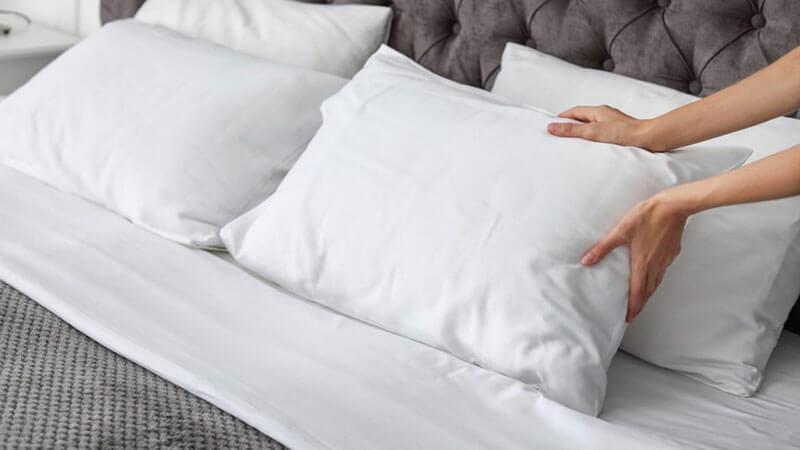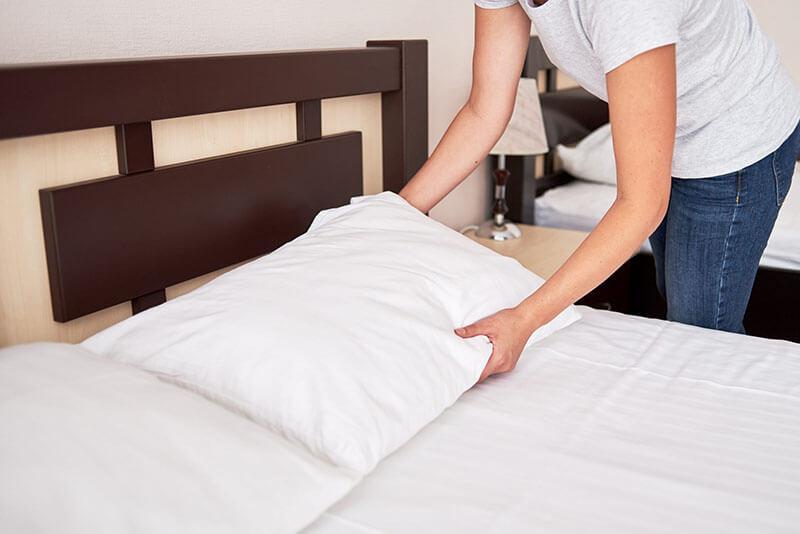Replace your pillow every year to two years, according to the majority of specialists. As a result, you can rest assured that you’re sleeping on pillows that are both supportive as well as clean and free of allergies. To make sure your pillows last as long as possible, make sure you take good care of them.
Your pillows will generally inform you when it’s time to change them. Getting out of bed in the morning with a painful neck or struggling to find a comfortable posture may indicate that your pillow isn’t supporting you properly. Pillows should be replaced when they begin to sag or develop lumps, just like a mattress. If you detect excessive yellowing or if your allergies are acting up at night, it may be time to invest in new pillows.
Pillows made of some materials are more durable than those made of others. In contrast to polyester pillows, latex pillows can last for up to three years. As well as a material’s specific type, other factors such as its quality, density, and thickness can significantly influence its performance. Investing in a pillow made of high-quality materials means that you won’t have to buy a new one as frequently.
To extend the life of your pillow and keep it clean, use a clean pillowcase and pillow. Every time you wash your sheets, you should wash your pillowcases, and many pillows can be machine washed and dried.

Why it’s Important to Replace Pillows
Pillows that are beyond their prime can cause allergic responses, acne breakouts, and tight muscles. Replacing pillows on a regular basis may seem inconvenient.
There are a number of allergies that can build up in an old pillow like dust mites and fungus, mold and pet hair. As a result, some people may suffer from runny noses, itchy skin, and irritated eyes when they sleep close to such allergens. Pillow-related allergies can be avoided by changing your cushions frequently or purchasing a pillow that is antibacterial and breathable in nature..
Sweat, drool, and other bodily fluids can seep through your pillowcases and leave yellow stains on your pillows. For persons with sensitive skin, these compounds may cause acne breakouts or rashes. Pillowcases and pillows should be washed frequently using a moderate detergent to remove buildup, and new pillows can provide a clean slate that won’t irritate skin.
Most importantly, pillows are designed to alleviate muscle tension and promote proper spinal alignment as you sleep. If your pillow has sagged or flattened over time, you may wake up feeling sore or unrefreshed because it is unable to provide the support you need. A flattened pillow can also cause painful shoulders in side sleepers. If your pillow no longer provides the support it used to, it’s time to get a new one. It’s only a matter of time before you run out of ideas.
When to Replace Your Pillow
Now that you know why you should change your pillows, you need to know when to do it. If you detect any of the following symptoms, it’s time to replace them:
- Neck pain keeps you awake at night
- In the mornings, your shoulder muscles are sore and tense.
- Headaches are keeping you up at night and preventing you from getting enough rest.
- You wake up in the middle of the night with an itchy throat, a runny nose, watery eyes, a rash, or trouble breathing because to allergy symptoms.
- Despite washing, you still see small yellow spots or stains on your pillows. They could be the result of traces of sweat, body oil, or even dust mite excrement.
- The lumps you feel in your pillow aren’t going away.
- It’s hard to get a good night’s sleep because your
- When your pillows can be folded in half without any difficulty

How To Maintain Your Pillows
Like other bedding accessories, pillows require regular cleaning and maintenance. A few years of proper care can lengthen the life of your pillow. In order to avoid ruining your pillows while washing or drying, check the instructions on the care label. There are some pillows that can only be washed by hand or in a washing machine. There are some that require spot or dry cleaning.
Washing
Once every four to six months, if your pillows can be washed in a machine, they should be washed in hot water. Your pillows will be free of allergens thanks to the high water temperature. Generally speaking, down-alternative synthetic pillows can be washed in the machine.
Try washing your pillows with a moderate liquid detergent. Your pillows should not be washed with other clothing or bed linens. The risk of overloading your washing machine is eliminated if you wash two pillows at a time.
Drying
You can dry your pillows in your dryer on a low heat setting or hang them out to dry on a clothesline. The pillows can be put in their coverings once they are entirely dry and there are no signs of moisture left in them. Mold thrives in moist conditions, and this might pose a risk to your cushions.
Pillow Cases
Pillowcases protect and decorate your pillows at the same time, making them both functional and fashionable. Typically, they come in a set with your bedding. For added protection, waterproof pillow coverings can be used.
Using the pillow protectors under your pillowcases is a great way to keep your pillows fresh. The pillow protector beneath your pillowcases minimizes moisture absorption, making your bed attractively beautiful. Every three to four weeks, unless the care label specifically states otherwise, you can machine wash your pillowcases and protectors.

Can you hand wash a pillow?
As long as the pillow’s care label doesn’t indicate dry cleaning, you can wash it by hand. It is possible to wash most down or down replacement pillows using either a machine or a gentle hand wash. Due to the dangers of machine washing, memory foam and latex pillows should only be washed spot-on.
How do I kill the dust mites in my pillow?
At least 130 degrees Fahrenheit, you can wash your pillows. If you can’t wash your pillows, you can destroy any bacteria on them by drying them for at least 15 minutes at 130 degrees Fahrenheit. It’s a good idea to check the care label before doing any of these.
How to fluff pillows?
Keep your pillows out on a sunny day for three to four hours to fluff them up. Your pillow is usually flattened by dampness or a lack of uniformly distributed fiberfill. Using the sun’s rays to dry out your cushions results in a fluffy pillow. The fiberfill inside the cushion can be adjusted by pulling the pillow from both ends and shaking it. Low-heat drying is also an effective method of keeping your pillow clean.
Conclusion
When it comes to getting a good night’s sleep, we tend to focus on our mattress and bedding. It is easy to ignore the importance of our pillows in improving our sleep, but this is not always the case. For a good night’s sleep, make sure your sheets are clean and supportive. If we notice any symptoms of wear on our pillows, we should get them replaced as soon as feasible.

![Top Rated CPAP Machine Buyer’s Guide [current_date format=’m/Y’]](https://bestpillowsleepers.com/wp-content/uploads/2023/03/best-cpap-machine-img_6405d72310053-400x300.jpg)
![The 11 Best Cooling Weighted Blankets [current_date format=’m/Y’]](https://bestpillowsleepers.com/wp-content/uploads/2023/01/best-cooling-weighted-blankets-img_63d4ff15c615d-400x300.jpg)
![Ultimate Guide to Choosing a Best Cooling Mattress Pads [current_date format=’m/Y’]](https://bestpillowsleepers.com/wp-content/uploads/2023/01/best-cooling-mattress-pads-img_63c403115126b-400x300.jpg)
![Ultimate Guide to Choosing a Best Cooling Mattress [current_date format=’m/Y’]](https://bestpillowsleepers.com/wp-content/uploads/2023/01/ultimate-guide-to-choosing-a-best-cooling-mattress-img_63bcdba870d77-400x300.jpg)
![Ultimate Guide to Choosing a Best Cooling Comforters [current_date format=’m/Y’]](https://bestpillowsleepers.com/wp-content/uploads/2023/01/ultimate-guide-to-choosing-a-best-cooling-comforters-img_63bba2f5cd3ce-400x300.jpg)